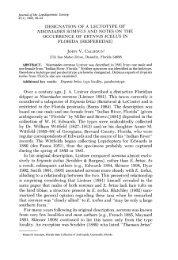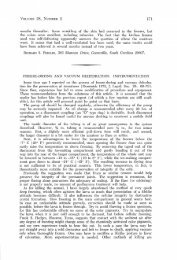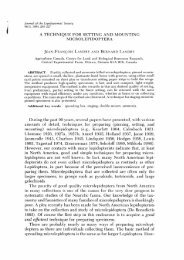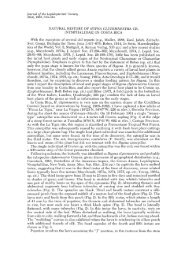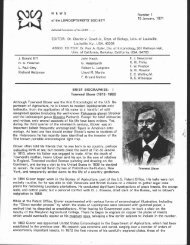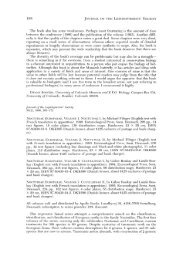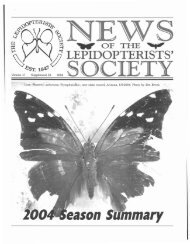Biology of Anaea ryphea - Yale University
Biology of Anaea ryphea - Yale University
Biology of Anaea ryphea - Yale University
Create successful ePaper yourself
Turn your PDF publications into a flip-book with our unique Google optimized e-Paper software.
250 JOURNAL OF THE LEPIDOPTERISTS' SOCIETY<br />
Leaf size depends on plant height: lO cm long on plants up to 2 m tall<br />
and 20 cm long on taller plants. The inflorescences are monoecious,<br />
with male flowers terminal. At the study site, flowers were seen during<br />
December. Other species <strong>of</strong> Croton are recorded as food plants for<br />
species <strong>of</strong> Nymphalidae (DeVries 1987) and Riodinidae (DeVries 1988).<br />
Croton floribundus is common in the Santa Genebra Reserve, in both<br />
sunny and shaded areas, as solitary individuals or in patches. It grows<br />
mostly along the edges <strong>of</strong> trails and is rare in the middle <strong>of</strong> the forest.<br />
The soil along the trails is mostly clay, and during the dry season the<br />
plants seem to resist desiccation. From Mayan, plants begin to dry out,<br />
sometimes being reduced to no more than a woody stem that puts out<br />
new leaves the next wet season. During the rainy season, the soil maintains<br />
a high water content. Along the reserve's central road (1,160 m<br />
long), I found 186 plants. All were mapped and marked for use in this<br />
study.<br />
During each visit I checked all leaves for larvae on the 186 marked<br />
plants. Eggs were difficult to detect, so exact numbers were not known<br />
until the following season. Twenty eggs were collected and taken into<br />
the laboratory. These eggs were the source <strong>of</strong> hatching time observations.<br />
In the field, each leaf with a larva was individually numbered<br />
because larvae stay on the same leaf most <strong>of</strong> the time. All larvae were<br />
measured and identified as to instar. Their height from the ground and<br />
the general aspect <strong>of</strong> the leaf were noted. With this methodology I was<br />
able to (1) follow the growth <strong>of</strong> every individual, (2) determine the<br />
duration <strong>of</strong> each instar in the field, and (3) assess mortality for each<br />
instar.<br />
RESUL TS AND DISCUSSION<br />
Oviposition<br />
A naea <strong>ryphea</strong> eggs are laid singly and usually one per leaf, in the<br />
central third <strong>of</strong> the under surface. Rarely, two or three eggs are laid.<br />
A similar oviposition pattern was described by Ramos (1984) for <strong>Anaea</strong><br />
troglodyta borinquenalis and by Muyshondt (1975b) for <strong>Anaea</strong> (Memphis)<br />
pithyusa. Females fly around the plant, inspecting leaves quickly<br />
before ovipositing. I could not tell whether eggs laid on the same leaf<br />
came from the same female. Placing one egg per leaf could eliminate<br />
competition during the early instars, when larvae have restricted movement.<br />
In Colon Province, Republic <strong>of</strong> Panama, 1991, while studying<br />
the same species, I saw females placing more than one egg on the same<br />
leaf <strong>of</strong> Croton billbergianus, although not sequentially. In each <strong>of</strong> the<br />
three cases observed, the female flew from one leaf to another, ovi-





